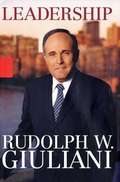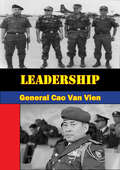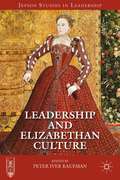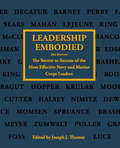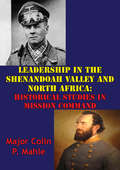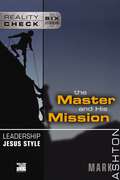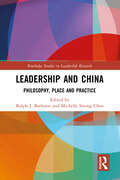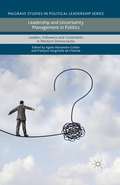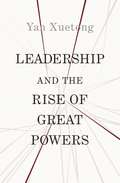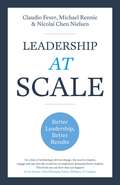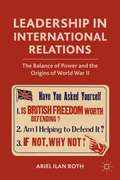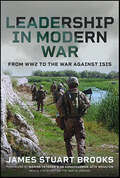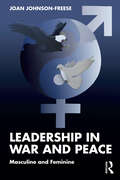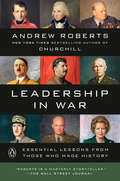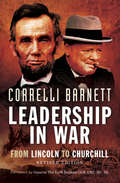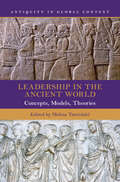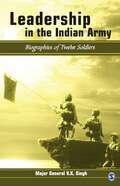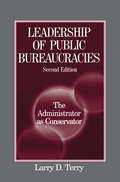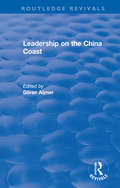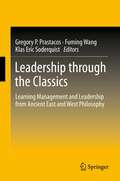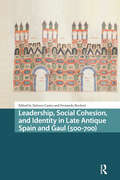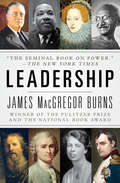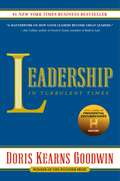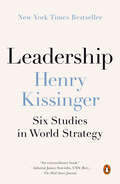- Table View
- List View
Leadership
by Ken Kurson Rudolph W. GiulianiHaving inherited a city ravaged by crime and crippled in its ability to serve its citizens, Giuliani shows how he found that every aspect of his career up to that point-from clerking for the formidable judge who demanded excellence (and rewarded it with a lifetime of loyalty) to busting organized crime during his years as a federal attorney -shaped his thinking about leadership and prepared him for the daunting challenges ahead. Giuliani's successes in turn strengthened his conviction about the core qualities required to be an effective leader, no matter what the size of the organization, be it an international corporation or a baseball team. In detailing his principles of leadership, Giuliani tells captivating stories that are personal as well as prescriptive.
Leadership (Indochina Monographs #11)
by General Cao Van VienThis monograph forms part of the Indochina Monograph series written by senior military personnel from the former Army of the Republic of Vietnam who served against the northern communist invasion.War and politics posed many challenges to South Vietnam's military leadership. Unlike his counterpart in some countries, the Vietnamese military commander was not simply a leader of men in combat. Depending on the level of command, he had to play his part in national politics, be himself a grass roots politician, or engage in political warfare. To achieve success, he was often expected to possess several qualities not always required of a professional military leader. The requirements of leadership, therefore, sometimes transcended the conventional framework of accepted rules and principles.Given these requirements and the fallibility of human nature, it had not always been easy to evaluate the total performance of our leadership. The dilemma we faced was that while professional competence during actual combat was a critical criteria, we could not tolerate deliberate aberrations in moral and social codes.In my analysis of the successes and failures of our leadership, I have endeavored to be fair and objective. If I seem to be laudatory of some officers while critical of others, it is not my intention to embarrass any individual. Performance has been the sole basis for all of my evaluations.
Leadership And Elizabethan Culture
by Peter Iver KaufmanLeadership an Elizabethan Culture studies the challenges confronted by government and church leaders (local and central), the counsel given them, the consequences of their decisions, and the views of leadership circulating in late Tudor literature and drama.
Leadership Embodied
by Joseph ThomasNow in its second edition, Leadership Embodied is an instructive collection of short biographical essays focusing on Navy and Marine Corps personnel, who have demonstrated notable leadership characteristics. While leaders are present in every aspect of human undertaking, leadership in this work is illustrated through the most dramatic and demanding of all human undertakings-war and the preparations for war. Wartime challenges are, because of the life and death nature of the affair, more monumental and exacting. All of these individuals have been selected because they dramatically shaped today's institutions, practices, and customs within the naval services. The contributions of these individuals should be required reading for any student of leadership because they each demonstrate a particular lesson for midshipmen on their journey to becoming a navy or Marine Corps officer.
Leadership In The Shenandoah Valley And North Africa: Historical Studies In Mission Command
by Major Colin P. MahleMission command, as outlined in Army Doctrine Reference Publication (ADRP) 6-0, Mission Command, is the contemporary philosophy through which army commanders combine mission, intent, and subordinate initiative to win in unified land operations. Though not known to them as mission command, prominent leaders such as Field Marshal Erwin Rommel and Major General Thomas J. "Stonewall" Jackson used similar concepts.This study specifically examines how these leaders employed three of the six principles outlined in current mission command doctrine. They are: (1) build cohesive teams through mutual trust, (2) exercise disciplined initiative, and (3) provide a clear commander's intent. Determining the methods that these commanders employed during their celebrated campaigns through the framework of mission command highlights characteristics that will benefit military leaders at all levels. The linkages between these historical campaigns and current mission command philosophy are the focus of this study.
Leadership Jesus Style: The Master and His Mission (Reality Check)
by Mark AshtonThe Reality Check series makes just one assumption: that you’re serious enough about your spiritual journey to investigate Christianity with an open mind. This isn’t about joining anyone’s religious club—it’s about being real with yourself and with the others in your group. Since no one has all the answers, there’s plenty of room for discussion. After all, if there is any truth to the Bible’s stories about Jesus, then one thing he’d welcome are questions and opinions that come from honest, earnest hearts.Whether you’re leading a corporation, a sports team, your family, or simply your own pursuits, issues such as mission, character, vision casting, and team building are critical to your success. Wouldn’t it be great to take lessons from a master leader? Here’s your opportunity. Nobody in history has surpassed Jesus of Nazareth in either methods or results. Find out his leadership secrets. They’re guaranteed to make you a better leader.Leadership Jesus Style includes these sessions: Upside-Down Leadership What’s Your Mission? Casting a Vision The Master Strategist Building a Team When Others FailFor the Group LeaderReality Check is for spiritual seekers of every persuasion. Uncompromisingly Christian in its perspective, it steers wide of pat answers and aims at honesty. This innovative and thought-provoking series will challenge you and those in your group to connect heart to heart as together you explore the interface between Jesus, the Bible, and the realities of this world in which we live.
Leadership Lessons And Remembrances From Vietnam
by Lt.-Gen. Herman Nickerson Jr. USMCIn view of his unique experiences as a senior Marine commander in Vietnam and his Extensive efforts to communicate his views and his combat knowledge to the troops he commanded, it was decided to republish a series of articles that Lieutenant General Herman Nickerson, Jr., wrote in 1969-1970 while he was Commanding General, III Marine Amphibious Force (III MAF), which were published in Sea Tiger; the weekly newspaper distributed throughout the III MAF area of northern South Vietnam. General Nickerson commanded the 1st Marine Division in Vietnam from 1 October 1966 to 31 May 1967 and returned to that embattled country to command the III MAF from 27 March 1969 through 9 March 1970. During this latter tour of duty, in order to make up in part for an in-person briefing and welcome he used to give incoming officers and staff non-commissioned officers of the 1st Division, he began writing a series of articles for publication in Sea Tiger. In these short pieces, he covered a wide range of topics, some related to combat service in Vietnam, but many more to the Vietnamese people and the role of Americans in their support.
Leadership and China: Philosophy, Place and Practice (Routledge Studies in Leadership Research)
by Ralph J. Bathurst Michelle Sitong ChenSince its opening in 1978, China has undergone radical change. By establishing special economic zones along its Eastern coastal borders under Deng Xioping’s tutelage, China entered the global market. Loosening controls from central government allowed for a more free-market approach that facilitated easier trading partnerships across national boundaries. Leadership and China: Philosophy, Place and Practice explores the impact of these changes today. Companies across the globe are doing business with Chinese counterparts, but recently the Western world has begun treating China with suspicion, with some commentators claiming nefarious aims on the part of Chinese Communist Party, and intentions of favoring China’s growing middle class and political elites, while impoverishing other international trading partners. This calls for wise leadership on both sides of the political divide and this book facilitates conversations that explore synergies between East and West, aiming to move past suspicion and discuss how leaders might work for the benefit of all humanity. With an orientation towards conversations rather than polemics, graduate students, scholars and business leaders across the globe will benefit from this book.
Leadership and Uncertainty Management in Politics: Leaders, Followers and Constraints in Western Democracies (Palgrave Studies in Political Leadership)
by François Vergniolle De ChantalThrough a range of international case studies from the USA, UK, France, Germany and Italy, this text assesses the conditions necessary for effective leadership and emphasizes the part played by uncertainty and division amongst followers.
Leadership and the Rise of Great Powers (The Princeton-China Series #11)
by Xuetong YanA leading foreign policy thinker uses Chinese political theory to explain why some powers rise as others decline and what this means for the international orderWhile work in international relations has closely examined the decline of great powers, not much attention has been paid to the question of their rise. The upward trajectory of China is a particularly puzzling case. How has it grown increasingly important in the world arena while lagging behind the United States and its allies across certain sectors? Borrowing ideas of political determinism from ancient Chinese philosophers, Leadership and the Rise of Great Powers explains China’s expanding influence by presenting a moral-realist theory that attributes the rise and fall of nations to political leadership. Yan Xuetong shows that the stronger a rising state’s political leadership, the more likely it is to displace a prevailing state in the international system.Yan defines political leadership through the lens of morality, specifically the ability of a government to fulfill its domestic responsibility and maintain international strategic credibility. Examining leadership at the personal, national, and international levels, Yan shows how rising states like China transform the international order by reshaping power distribution and norms. Yan also considers the reasons for America’s diminishing international stature even as its economy, education system, military, political institutions, and technology hold steady. The polarization of China and the United States will not result in another Cold War scenario, but their mutual distrust will ultimately drive the world center from Europe to East Asia.Using the lens of classical Chinese political theory, Leadership and the Rise of Great Powers offers a provocative, alternative perspective on the changing dominance of nations on the global stage.
Leadership at Scale: Better leadership, better results
by Claudio Feser Michael Rennie Nicolai NielsenLeadership effectiveness drives organizational performance, yet almost half of all organizations face some kind of leadership gap that they are not able to fill. In Leadership at Scale, McKinsey experts C laudio Feser, Michael Rennie and Nicolai Nielsen share their secrets on how to increase leadership effectiveness across an organization. Using extensive research, distilled insights from McKinsey's leadership development work in practice, and lessons from a highly successful leadership development program, this book will focus on the leadership behaviors that matter most.
Leadership in International Relations
by Ariel Ilan RothUsing the engaging case of British security policy between the world wars, this book argues that an effective balance of power, which is the key to a stable international system, is a deliberate act of policy and that leaders play a determinative role in building an effective balance.
Leadership in Modern War: From WW2 to the War Against ISIS
by James Stuart BrooksHow would you react under fire? Fight or flight? What if you were in charge of a squad of men, with their lives in your hands? The next decision you make could be fatal for you and your comrades or could be devastating to your enemy. The wrong decision could haunt you for the rest of your career and beyond. The decisions taken by commanders in the field are analyzed in a detached manner by historians. But what, for example, was the thought process of a reconnaissance tank officer operating far ahead of any supporting troops in the Second World War, or a machine-gunner trying to differentiate friend from foe in the Gulf War? How might a British infantry officer in the Iraq War deal with the situations he faced in combat, or a platoon commander in the War Against ISIS, where the enemy had no fear of dying and even embraced it? How do you come to terms with the consequences of your decisions, the right ones as well as the tragically wrong ones? James Brooks presents defining moments such as these to put you in the shoes of the decision-maker. You can decide when to cross a bridge in Taliban territory, whether to land a helicopter under fire to rescue Marines in danger, and how to lead a command center targeting ISIS through air strikes. These decisions, compared with what the veterans did themselves, teach more about humanity than they do about the tactics of war and serve as lessons for the decisions we face in everyday life. In a career that traced the rise and fall of ISIS from 2014 to 2021, James served in the US Marine Corps as a scout sniper platoon commander, intelligence officer, and counter-propaganda mission lead. After two deployments to the Middle East and a year-and-a-half fighting ISIS propaganda online, James returned to his hometown to teach a subject called “Perspectives in Modern War” to high school seniors. Building from the stories of his own service, as well as those of the men and women he fought alongside, in Leadership in Modern War James captures these lessons and explores just what it is like to be on the front line facing your foe. Warfare has changed in the twenty-first century, but the enduring lessons of conflict remain the same. It is brutal and unforgiving – but it is also character-defining.
Leadership in War and Peace: Masculine and Feminine
by Joan Johnson-FreeseThis book offers a gendered perspective on leadership in war and peace, considering leadership in its complexity and presenting a practical examination of both leadership successes and failures.The work challenges readers to think through and discuss specific aspects of leadership, including how and why leadership diversity matters and the ethical challenges presented by the revolving door of the military–industrial complex. Further, leaders responsible for decisions involving war and peace must be able to understand, appreciate, and communicate effectively with everyone they work with and have a repertoire of leadership styles to use depending on context. The book represents an excellent tool for developing such skills, as it uniquely considers leadership through both male and female lenses, along with the experiences and perspectives of multiple military, government, and industry leaders interviewed by the author, making it both relatable and informative.This book will be of much interest to students of gender studies, leadership studies, defense studies, and military studies in general, as well as military and security practitioners.
Leadership in War: Essential Lessons from Those Who Made History
by Andrew RobertsA comparison of nine leaders who led their nations through the greatest wars the world has ever seen and whose unique strengths--and weaknesses--shaped the course of human history, from the bestselling, award-winning author of Churchill and NapoleonTaking us from the French Revolution to the Cold War, Andrew Roberts presents a bracingly honest and deeply insightful look at nine major figures in modern history: Napoleon Bonaparte, Horatio Nelson, Winston Churchill, Adolf Hitler, Joseph Stalin, George C. Marshall, Charles de Gaulle, Dwight D. Eisenhower, and Margaret Thatcher. Each of these leaders fundamentally shaped the outcome of the war in which their nation was embroiled. Is war leadership unique, or did these leaders have something in common, traits and techniques that transcend time and place and can be applied to the essential nature of conflict?Meticulously researched and compellingly written, Leadership in War presents readers with fresh, complex portraits of leaders who approached war with different tactics and weapons, but with the common goal of success in the face of battle. Both inspiring and cautionary, these portraits offer important lessons on leadership in times of struggle, unease, and discord. With his trademark verve and incisive observation, Roberts reveals the qualities that doom even the most promising leaders to failure, as well as the traits that lead to victory.
Leadership in War: From Lincoln to Churchill
by Correlli BarnettFrom the author of The Audit of War comes &“a valuable read for those interested in leadership&” through the 19th and early 20th centuries (StrategyPage). Throughout history, there have been those who become leaders through effort, fate, violence, or simple luck. They are leaders of men, of armies, and of nations. Some strive for the best of humanity, while others spread death and destruction. But all change history. In this controversial study, Correlli Barnett examines the strengths and weaknesses of twenty wartime leaders in the nineteenth and early twentieth centuries. He considers the extraordinary difficulties they faced, and analyses how they performed and what they achieved. Were they successful, or were they beaten down by the burden of their roles? His book focuses on men from different backgrounds, from three continents in conflicts ranging from the American Civil War to the Second World War. They include statesmen such as Abraham Lincoln, Adolf Hitler, and Winston Churchill; generals like Ulysses S. Grant, Douglas Haig, Erwin Rommel, Georgy Zhukov, and Dwight D. Eisenhower; and admirals like Isoroku Yamamoto and Bertram Ramsay. These leaders demonstrated fascinating contrasts of personal character, styles of leadership, and aptitude for command as they grappled with the daunting professional problems that confronted them. Here, the author demolishes hallowed reputations, rehabilitates the unjustly scapegoated, and shines an unfiltered light on those who have shaped our world.
Leadership in the Ancient World: Concepts, Models, Theories (Antiquity in Global Context)
by Melina TamiolakiLeaders abounded in the ancient world, from kings, pharaohs, emperors, tyrants, politicians, and orators to generals, minor officials and intellectuals. This book opens fresh perspectives on leadership by examining under-explored topics, posing new questions and revisiting old concepts. In particular, it seeks to shift attention from constitutional issues stricto sensu (such as kingship, monarchy, tyranny, etc.) or, more productively, to prompt a re-examination of these issues through the lens of leadership. The volume includes chapters on a range of cultures from across the ancient world in order to promote comparative reflection. Key questions include whether some models of good and bad leadership were universal among ancient cultures or exhibited differences? Why did a certain culture emphasise one leadership quality while another insisted on another? Why did only some cultures develop a theoretical discourse on leadership? How did each culture appropriate, define, redefine (or react) to existing concepts of leadership?
Leadership in the Indian Army: Biographies of Twelve Soldiers
by V K SinghSpanning over 60 years of military leadership in India, this unique book brings to life the human side of twelve exceptional military leaders. Unlike traditional biographies of combat leaders which focus primarily on military operations or regimental histories, the author concentrates on personal accounts, anecdotes and reminiscences in order to highlight these leaders` personalities, and to draw out the human face behind the military facade. The author argues that written records tend to glorify the actions of battalions as well as individuals, magnifying achievements while suppressing the mistakes and glossing over failures. This book, on the other hand, provides a truer picture of the strength of character and convictions of each of these leaders. The book throws new light on many historical events and the role of political leaders during India`s fight for independence and the partitioning of the subcontinent. The author gives an overview of India`s military history after independence, including major operations such as the wars with China in 1962, and with Pakistan in 1947, 1965 and 1971. He describes many hitherto unknown or little known facts and incidents concerning smaller operations like Nathu La in 1967 and Goa in 1962.
Leadership of Public Bureaucracies: The Administrator as Conservator
by Larry D. TerryThe revolution in public management has led many reformers to call for public managers to reinvent themselves as public entrepreneurs. Larry D. Terry opposes this view, and presents a normative theory of administrative leadership that integrates legal, sociological, and constitutional theory.
Leadership on the China Coast (Routledge Revivals)
by Göran AijmerOriginally published in 1984, Leadership on the China Coast brings together four independent empirical studies of leadership exercised on China’s southern coastland. Written by academics from across several disciplines, the book presents a wealth of research on methods of constructing authority in China, and on informal politics as a process integrated with formal bureaucratic administrations in which idiosyncratic leadership operates on all levels under shared ideological and legal constraints. Leadership on the China Coast will appeal to those with an interest in the social and political history of China.
Leadership through the Classics: Learning Management and Leadership from Ancient East and West Philosophy
by Gregory P Prastacos Klas Eric Soderquist Fuming WangThe unforeseeably complex socio-economic and environmental challenges of the 21st century must be tackled by placing faith in the power of mankind to integrate established wisdom and new knowledge, and in our ability to collaborate for a sustainable future. Departing from this, a global 2011 conference debating papers devoted to the impact of ancient philosophy, focusing on Confucius and Aristotle, in modern leadership and management was organized by Hanban, the Athens University of Economics & Business, and the University of International Economics & Business, Beijing, China. A rich sourcebook for a broad audience, this unique volume presents the wide array of conference contributions by international thought-leaders. Departing from a foundation of general concepts of ethics and leadership the book then delves into questions about how philosophy shape emerging economic and business systems, to end with direct lessons from ancient philosophy for contemporary business challenges.
Leadership, Social Cohesion, and Identity in Late Antique Spain and Gaul (Late Antique and Early Medieval Iberia)
by Dolores Castro Fernando RuchesiThe replacement of the Roman Empire in the West with emerging kingdoms like Visigothic Spain and Merovingian Gaul resulted in new societies, but without major population displacement. Societies changed because identities shifted and new points of cohesion formed under different leaders and leadership structures. This volume examines two kingdoms in the post-Roman west to understand how this process took shape. Though exhibiting striking continuities with the Roman past, Gaul and Spain emerged as distinctive, but not isolated, political entities that forged different strategies and drew upon different resources to strengthen their unity, shape social ties, and consolidate their political status.
Leadership: Clinton-gore Leadership And The Perils Of Moderation
by James MacGregor BurnsA Pulitzer Prize–winning historian examines transformational leaders from Moses to Machiavelli to Martin Luther King Jr. in this &“impressive book&” (The Washington Post). Historian and political scientist James MacGregor Burns has spent much of his career documenting the use and misuse of power by leaders throughout history. In this groundbreaking study, Burns examines the qualities that make certain leaders—in America and elsewhere—succeed as transformative figures. Through insightful anecdotes and historical analysis, Burns scrutinizes the charisma, vision, and persuasive power of individuals able to imbue followers with a common sense of purpose, from the founding fathers to FDR, Gandhi to Napoleon. Since its original publication in 1970, Leadership has set the standard for scholarship in the field.
Leadership: In Turbulent Times
by Doris Kearns GoodwinFrom Pulitzer Prize–winning author and esteemed presidential historian Doris Kearns Goodwin, an invaluable guide to the development and exercise of leadership from Abraham Lincoln, Theodore Roosevelt, Lyndon B. Johnson, and Franklin D. Roosevelt. The inspiration for the multipart HISTORY Channel series Abraham Lincoln and Theodore Roosevelt.&“After five decades of magisterial output, Doris Kearns Goodwin leads the league of presidential historians&” (USA TODAY). In her &“inspiring&” (The Christian Science Monitor) Leadership, Doris Kearns Goodwin draws upon the four presidents she has studied most closely—Abraham Lincoln, Theodore Roosevelt, Franklin D. Roosevelt, and Lyndon B. Johnson (in civil rights)—to show how they recognized leadership qualities within themselves and were recognized as leaders by others. By looking back to their first entries into public life, we encounter them at a time when their paths were filled with confusion, fear, and hope. Leadership tells the story of how they all collided with dramatic reversals that disrupted their lives and threatened to shatter forever their ambitions. Nonetheless, they all emerged fitted to confront the contours and dilemmas of their times. At their best, all four were guided by a sense of moral purpose. At moments of great challenge, they were able to summon their talents to enlarge the opportunities and lives of others. Does the leader make the times or do the times make the leader? &“If ever our nation needed a short course on presidential leadership, it is now&” (The Seattle Times). This seminal work provides an accessible and essential road map for aspiring and established leaders in every field. In today&’s polarized world, these stories of authentic leadership in times of apprehension and fracture take on a singular urgency. &“Goodwin&’s volume deserves much praise—it is insightful, readable, compelling: Her book arrives just in time&” (The Boston Globe).
Leadership: Six Studies in World Strategy
by Henry KissingerThe New York Times bestsellerHenry Kissinger, consummate diplomat and statesman, examines the strategies of six great twentieth-century figures and brings to life a unifying theory of leadership and diplomacy&“An extraordinary book, one that braids together two through lines in the long and distinguished career of former Secretary of State Henry Kissinger...In Leadership he presents a fascinating set of historical case studies and political biographies that blend the dance and the dancer, seamlessly.&” - James Stavridis, The Wall Street Journal&“Leaders,&” writes Henry Kissinger in this compelling book, &“think and act at the intersection of two axes: the first, between the past and the future; the second, between the abiding values and aspirations of those they lead. They must balance what they know, which is necessarily drawn from the past, with what they intuit about the future, which is inherently conjectural and uncertain. It is this intuitive grasp of direction that enables leaders to set objectives and lay down a strategy.&” In Leadership, Kissinger analyses the lives of six extraordinary leaders through the distinctive strategies of statecraft, which he believes they embodied. After the Second World War, Konrad Adenauer brought defeated and morally bankrupt Germany back into the community of nations by what Kissinger calls &“the strategy of humility.&” Charles de Gaulle set France beside the victorious Allies and renewed its historic grandeur by &“the strategy of will.&” During the Cold War, Richard Nixon gave geostrategic advantage to the United States by &“the strategy of equilibrium.&” After twenty-five years of conflict, Anwar Sadat brought a vision of peace to the Middle East by a &“strategy of transcendence.&” Against the odds, Lee Kuan Yew created a powerhouse city-state, Singapore, by &“the strategy of excellence.&” And, though Britain was known as &“the sick man of Europe&” when Margaret Thatcher came to power, she renewed her country&’s morale and international position by &“the strategy of conviction.&” To each of these studies, Kissinger brings historical perception, public experience and—because he knew each of the subjects and participated in many of the events he describes—personal knowledge. Leadership is enriched by insights and judgements that only Kissinger could make and concludes with his reflections on world order and the indispensability of leadership today.
